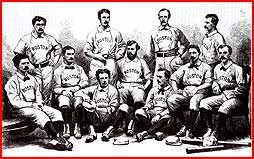
|
||
| Premiere issue | Autumn 2002 | |
Autumn 2002 Home |
| Culture/ Politics |
| Fiction |
| Film |
| Music |
| Technology |
| Theater |
| About / Contact |
| Archive |
| Current Home Page |

Asterisks all around
What with threats of contraction, the untimely deaths of several players and — could it be? — Minnesota in a pennant race, it's been an odd summer for baseball. In fact, the late summer talk of a possible strike was about the most normal part of the season.
Yet, perhaps the most dismaying development in a summer of discontent is the revelation of steroid use by some former players.
Almost as dismaying is the now widespread assumption that any bulked-up player must be on steroids. This sort of mentality, coupled to the strong herding instincts among members of the press, has led to talk among some sportswriters and broadcasters that Barry Bonds' impressive and growing home run records ought to have the proverbial asterisk placed beside them.
While Bonds has admitted to using legal and non-steroid muscle-enhancing supplements, many now assume that his recent bulking up has more in common with the admission by the recently retired Ken Caminiti and Jose Canseco that they took steroids. Given the still-fresh memory of Mark McGwire's supplement-enhanced eclipse of Roger Maris' single-season home run record (itself since passed by Bonds), there are those who argue that the sanctity of the sport demands we differentiate these achievements from those posted in an earlier, more pristine time.
Here in Turbula's beachside offices where the only supplements we put into our bodies come in 6-packs, 12-packs and kegs, it seems to us that if we're going to place asterisks beside the achievements of Bonds, McGwire and Sammy Sosa, then certainly Cobb, Ruth and — yes — even the recently departed and quick-frozen Ted Williams ought to have asterisks placed next to their records as well. For Cobb's career batting average record, Ruth's once-hallowed career home run mark, and even Williams' sacred .400 season were all achieved against pitching made artificially inferior.
 Done gasping? Ready to sputter out the usual inanities about today's "diluted" pitching? (More on that beloved myth below.)
Done gasping? Ready to sputter out the usual inanities about today's "diluted" pitching? (More on that beloved myth below.)
Then consider this: Baseball's "glory years" are a lie — the competition was watered down all through the 1920s, '30s and '40s, and no-talent hacks who never should have risen above Double A made it to the Bigs only because black and Latin players were banned from Major League baseball.
Would Ted Williams have hit .400 if he'd had to bat against Hilton Smith or Satchel Paige or any of the other great Negro League pitchers a couple times a year?
Unlikely.
What if he'd had to go against the best Latin pitchers of his day? They were also excluded from Major League baseball during his career.
Now, not only do you have to face the best white, black and Latin pitchers the United States, Mexico and Central America and the Caribbean produce, but increasingly you're up against the best Japanese and Korean pitchers as well. And how long before Taiwan and the Philippines are sending their best arms over here?
As Mickey Mantle pointed out in his high-living autobiography, "The Mick," during baseball's supposedly golden era you didn't have the high-powered closers you have today. Relievers weren't skilled specialists — but instead pitchers who weren't good enough to start or veterans who'd blown out their arms and survived on their wits.
Mantle argued that in his day if you chased the ace, you could pad your statistics on the has-beens and burnouts in the bullpen. Today, you chase a $15 million starter, they bring in a $20 million closer who kills your stats.
Fairness demands we admit to the fact that contemporary hitters have it tougher all around. That's why some of the game's best pure hitters — men like Rod Carew, Pete Rose, Tony Gwynn and Larry Walker — have been unable to hit .400 over the course of a season in the 60 years since Williams last did it.
It's also why Williams' entry in the record books as the last man to hit .400 for a full season may last longer than any of the other major offensive records — Bond's newly minted single-year home run tally, Rose's career hits total, Hank Aaron's home run total, even Rickey Henderson's still-growing career steals mark may all fall before another batter matches Williams' .400.
Give that man an asterisk ...
Diluted sportswriting, maybe
Here at Turbula's lavish offices in sun-sprayed California, we've noticed that one can hardly pick up a sports page anymore without reading that tired old cliche about the diluted pitching. How expansion has ruined baseball by creating a need for more quality pitchers than exist — allowing home run records to be shattered on an almost annual basis.
Of course, even we're bright enough to notice that it's on the sports page where we're reading this claim — not a mathematics journal.
For even a simple grasp of math (beyond most sports writers, it would seem) illustrates the point that because of both population growth and the racial integration of the sport, major league baseball pitchers today represent a smaller percentage of the population they're drawn from than in the 1930s.
That's the opposite of dilution — and helps explain the above-illustrated fact that no one has batted .400 in more than half a century.
In 1035, there were just over 125 million Americans. But about 10 percent of the population then was black, and unable to play in the white big leagues. With 16 teams then, and most teams using 13 pitchers a year, the ration of major league pitchers to white population base was 1:540,000.
Today, the U.S. population is 289 million — and every racial group is now welcomed into major league baseball. With 30 teams today, most carrying about 12 pitchers — but going through about 16 per year (the figure we'll use to answer the dilution crowd ahead of time), there are about 480 big league throwers over the course of any given season. That leads to a ratio of 1 pitcher for each 602,000 Americans — or fewer pitchers per population than in 1935.
So much for dilution.
And in fact, that's not really the most accurate number — it's actually even less diluted than that. Major league baseball today recruits heavily in many Latin American countries, including the Dominican Republic (8.6 million), Mexico (102 million) and Venezuela (24 million) — meaning their best players come here for the big money they can't earn at home. Add those countries' populations in, and you get a total of 423 million. We won't add in Japan or Korea since most of their best players still remain at home to play professionally.
But that leads to a true ratio of 1:881,000 — or a decline of more than 60 percent in the ratio since 1935.
 On the other hand, if you want to talk about the dilution of sportswriting since the 1930s — if you want to ask where are the modern Red Smiths and Grantland Rices and Jim Murrays and Si Buricks and Jack Murphys ... well, we don't need a calculator to tell you that the caliber of sportswriting isn't what it once was ...
On the other hand, if you want to talk about the dilution of sportswriting since the 1930s — if you want to ask where are the modern Red Smiths and Grantland Rices and Jim Murrays and Si Buricks and Jack Murphys ... well, we don't need a calculator to tell you that the caliber of sportswriting isn't what it once was ...
Saving the national pastime
Now that baseball's owners and players have managed — for the first time — to avoid a work stoppage during contract negotiations, the financial whizzes here at Turbula have some free advice for them.
The owners claim they're losing money, the players say they need more of the owners' money — and the folks who actually provide both sides with their money (that would be us) feel like we're being screwed by both sides.
 If the owners were serious about fixing the financial health of the sport, they'd offer each other and the players profit-sharing. They'd have to open their books for that, which being as secretive as most rich folks are they wouldn't much like, but on the upside they'd no longer have to haggle over money every couple of years.
If the owners were serious about fixing the financial health of the sport, they'd offer each other and the players profit-sharing. They'd have to open their books for that, which being as secretive as most rich folks are they wouldn't much like, but on the upside they'd no longer have to haggle over money every couple of years.
Offer the players 40 percent or 45 percent of the game's profits — and in return, demand that the players sign a 10-, 15- or even 20-year contract. If the game does well, that 40 percent the players are getting will be worth more. Maybe the reality that performance and behavior impact their income might get even a Barry Bonds to quit behaving like a constant sore-head.
Oh, and if the owners really want to simplify their life, once you have a profit-sharing plan in place, you can stop negotiating with each individual player. Simply make out a check to the players' union each year, mail it off — and let them figure out how to divvy it up ...
Rating team owners
The ongoing spat between young, brash and bratty Washington Redskins owner Daniel Snyder and longtime Browns/Ravens owner Art Modell is nothing if not silly.
Being the populists we are, though, Americans love to watch feuding millionaires. And so Snyder's attack of Modell's record as an NFL owner in Newsweek magazine in late August launched an equally rabid counter-attack from the Modell camp.
Now, Snyder, who has owned the Redskins for just three years, may have been out of line in criticizing Modell's winning percentage. Modell has won two championships in 40 years — not the greatest record, perhaps, but light years ahead of clubs like the Chicago Cubs or Boston Red Sox. And the Clippers are unlikely to win an NBA championship for another 400 years if Donald Sterling is still owner.
Snyder is loud, cocky and obnoxious. His rudeness to employees is inexcusable, his impatience costly. He had to pay Marty Schottenheimer millions to buy out his contract after only one season, replacing the proven NFL winner with the unproven Steve Spurrier from the University of Florida. (However, since Turbula's luxury skybox is in San Diego's Qualcomm Stadium, where Schottenheimer landed with the Chargers, we're willing to benefit from Snyder's impetuousness).
Having said all that, here's our thought on ranking sports team owners: If 40 years from now, Snyder's Redskins are still in Washington — if he shows loyalty to the fans who have supported his team and thus him, then we'll judge him as superior to Modell and never mind the championships.
Modell's stock as an owner, and indeed human being, dropped faster than the value of Martha Stewart's stock holdings when he slinked out of Cleveland despite years of sold-out games and unflagging fan loyalty. Turbula has deep roots in Baltimore, and like many old-school Colts fans will never accept the Ravens as a legitimate replacement. What Modell did to Cleveland is no different from what the Irsay family did in moving the Colts out of Baltimore.
Some things remain more important than winning ...
![]()
Autumn 2002 Culture & Politics | Autumn 2002 Main Page
Current Home Page
Copyright © Turbula.net